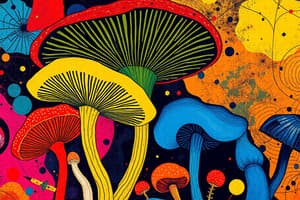Podcast
Questions and Answers
What is the primary mode of nutrition for fungi?
What is the primary mode of nutrition for fungi?
- Holozoic mode of nutrition
- Photosynthesis
- Saprophytic mode of nutrition
- Absorptive mode of nutrition (correct)
What is the term for fungi that form mutualistic relationships with plant roots?
What is the term for fungi that form mutualistic relationships with plant roots?
- Mycorrhizal fungi (correct)
- Saprotrophs
- Endophytes
- Lichens
What is the role of fungi in ecosystems?
What is the role of fungi in ecosystems?
- Producers
- Herbivores
- Decomposers (correct)
- Omnivores
What is the term for single-celled fungi that reproduce by budding?
What is the term for single-celled fungi that reproduce by budding?
What is the function of fruiting bodies in fungi?
What is the function of fruiting bodies in fungi?
What is the importance of fungi in medicine?
What is the importance of fungi in medicine?
Flashcards are hidden until you start studying
Study Notes
Characteristics of Fungi
- Eukaryotic organisms
- Heterotrophic (obtain energy by decomposing organic matter or forming symbiotic relationships)
- Cell walls composed of chitin
- Absorptive mode of nutrition (release enzymes to break down organic matter)
Types of Fungi
- Mushrooms: fruiting bodies of fungi, above-ground structures producing spores
- Molds: multicellular fungi, often forming visible growths on surfaces
- Yeasts: single-celled fungi, reproducing by budding
Reproduction in Fungi
- Spores: similar to seeds in plants, allow for dispersal and reproduction
- Fruiting bodies: structures that produce spores, e.g., mushrooms
- Vegetative reproduction: fragmentation, budding, or fission
Symbiotic Relationships
- Mycorrhizal fungi: form mutualistic relationships with plant roots, enhancing nutrient uptake
- Lichens: fungi living in symbiosis with algae or cyanobacteria
- Endophytes: fungi living within plant tissues, promoting plant growth
Ecological Roles
- Decomposers: fungi break down organic matter, recycling nutrients
- Saprotrophs: obtain energy by decomposing dead organic matter
- Mutualists: form beneficial relationships with other organisms
Importance of Fungi
- Food source: edible mushrooms, yeast in baking and brewing
- Medicine: antibiotics, cancer treatments, and other pharmaceuticals derived from fungi
- Ecological balance: fungi play a crucial role in ecosystem function and nutrient cycling
Characteristics of Fungi
- Fungi are eukaryotic organisms
- They are heterotrophic, obtaining energy by decomposing organic matter or forming symbiotic relationships
- Fungal cell walls are composed of chitin
- They have an absorptive mode of nutrition, releasing enzymes to break down organic matter
Types of Fungi
- Mushrooms are fruiting bodies of fungi, above-ground structures that produce spores
- Molds are multicellular fungi that often form visible growths on surfaces
- Yeasts are single-celled fungi that reproduce by budding
Reproduction in Fungi
- Spores are similar to seeds in plants, allowing for dispersal and reproduction
- Fruiting bodies are structures that produce spores, such as mushrooms
- Vegetative reproduction occurs through fragmentation, budding, or fission
Symbiotic Relationships
- Mycorrhizal fungi form mutualistic relationships with plant roots, enhancing nutrient uptake
- Lichens are fungi living in symbiosis with algae or cyanobacteria
- Endophytes are fungi that live within plant tissues, promoting plant growth
Ecological Roles
- Fungi act as decomposers, breaking down organic matter and recycling nutrients
- Saprotrophs obtain energy by decomposing dead organic matter
- Mutualists form beneficial relationships with other organisms
Importance of Fungi
- Fungi are a food source, with edible mushrooms and yeast used in baking and brewing
- Fungi have medicinal importance, with antibiotics, cancer treatments, and other pharmaceuticals derived from them
- Fungi play a crucial role in ecosystem function and nutrient cycling, maintaining ecological balance
Studying That Suits You
Use AI to generate personalized quizzes and flashcards to suit your learning preferences.




